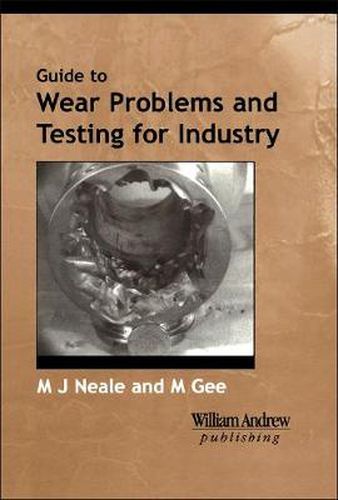Readings Newsletter
Become a Readings Member to make your shopping experience even easier.
Sign in or sign up for free!
You’re not far away from qualifying for FREE standard shipping within Australia
You’ve qualified for FREE standard shipping within Australia
The cart is loading…






Machine component wear is one of the costliest problems within industry. In fact, a 1997 survey in the UK placed wear costs at 25 per cent of turnover, or approximately USD1 billion. In many cases, making design and or material changes can reduce this cost by 50 per cent or more! This handbook reviews component wear, and guides the reader through solutions to wear problems, testing methods for materials and wear mechanisms, and information on wear performance of different materials for components. The bottom line is that it helps to reduce ‘the bottom line’ removing risks associated with changes to machinery. This book is based on practical use. It outlines the following practices: reviews of wear mechanisms that occur in various types of machinery and solutions to industrial wear problems; guides to relative wear performance of different component materials; comparison of the wear performance of those materials; reviews of laboratory tests to simulate wear, and selection of appropriate tests; identification of improved materials; and examination of worn surfaces. Key Features: Brilliantly illustrated with tables, photos of typical wear patterns, and line diagrams of test apparatus; Includes eight page color section; Contents based on four-year study drawing on international experience of industrial wear problems and in-depth testing at research laboratories. Contents: Introduction; Industrial Wear Problems - Types of wear; Identification of the type of wear; Assessing the problem; Improvement by use of alternative materials; Wear testing of materials. Wear Tests to Stimulate Practical Conditions - The wear tests available; Important factors in practical simulation; The selection of suitable test machines and their important design factors; General procedures in tests to ensure simulation. A Guide to Wear Test Selection. A Guide to the Examination of Worn Surfaces - Sample preparation; Surface appearance; Topographical information including surface finish. A Summary of the Approach to Wear Testing - Identification of a wear test problem; Identification of the dominant wear mechanism; Deciding on the action to be taken; Choosing an appropriate wear test; Planning an appropriate series of tests; Carrying out the wear test; Planning an appropriate series of tests; Carrying out the wear test program; Assessing the results. Appendix A - Description of Recommended Tests and their Operating Conditions; Appendix B - Recommended Detailed Test Procedures for the Various Tests; Appendix C - Guide to Notation; Appendix D - Bibliography for Further Reading.
$9.00 standard shipping within Australia
FREE standard shipping within Australia for orders over $100.00
Express & International shipping calculated at checkout
Machine component wear is one of the costliest problems within industry. In fact, a 1997 survey in the UK placed wear costs at 25 per cent of turnover, or approximately USD1 billion. In many cases, making design and or material changes can reduce this cost by 50 per cent or more! This handbook reviews component wear, and guides the reader through solutions to wear problems, testing methods for materials and wear mechanisms, and information on wear performance of different materials for components. The bottom line is that it helps to reduce ‘the bottom line’ removing risks associated with changes to machinery. This book is based on practical use. It outlines the following practices: reviews of wear mechanisms that occur in various types of machinery and solutions to industrial wear problems; guides to relative wear performance of different component materials; comparison of the wear performance of those materials; reviews of laboratory tests to simulate wear, and selection of appropriate tests; identification of improved materials; and examination of worn surfaces. Key Features: Brilliantly illustrated with tables, photos of typical wear patterns, and line diagrams of test apparatus; Includes eight page color section; Contents based on four-year study drawing on international experience of industrial wear problems and in-depth testing at research laboratories. Contents: Introduction; Industrial Wear Problems - Types of wear; Identification of the type of wear; Assessing the problem; Improvement by use of alternative materials; Wear testing of materials. Wear Tests to Stimulate Practical Conditions - The wear tests available; Important factors in practical simulation; The selection of suitable test machines and their important design factors; General procedures in tests to ensure simulation. A Guide to Wear Test Selection. A Guide to the Examination of Worn Surfaces - Sample preparation; Surface appearance; Topographical information including surface finish. A Summary of the Approach to Wear Testing - Identification of a wear test problem; Identification of the dominant wear mechanism; Deciding on the action to be taken; Choosing an appropriate wear test; Planning an appropriate series of tests; Carrying out the wear test; Planning an appropriate series of tests; Carrying out the wear test program; Assessing the results. Appendix A - Description of Recommended Tests and their Operating Conditions; Appendix B - Recommended Detailed Test Procedures for the Various Tests; Appendix C - Guide to Notation; Appendix D - Bibliography for Further Reading.